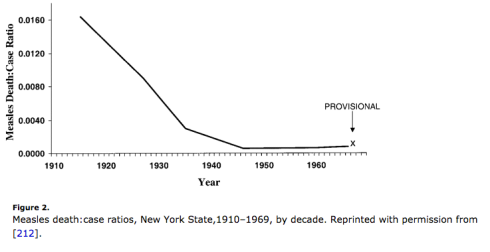I see a lot of headlines in my Facebook newsfeed about the new measles pandemic. It’s usually paired with commentary about how “anti-vaxxers” are irresponsible, reckless and should bury their heads in shame.
We aren’t going to vaccinate our son and since none of my friends that know ask me about why we came to that decision (but surely want to know our reasoning), I’d like to share what lead me to this decision.
But first, some background on me. I have never been one to take anything at face value, especially from someone in a position of power or authority. From my days as an activist teen, I always asked WHY. And as an adult, and especially as a mother, I must know why. WHY *must* I vaccinate? Here are (what I think) are the main arguments for vaccination:
1. It will keep your child from contracting preventable, potentially life-threatening diseases
2. It’s your societal duty to ensure that there’s herd immunity for those that cannot be vaccinated
3. There’s a measles pandemic because people don’t vaccinate!
Those are the biggies, right? There are others, of course (“because my doctor told me to”), but I think these are the most prevalent.
Let’s face it, there is a LOT of misinformation out there. I made the mistake a year or so ago of publicly sharing an article about vaccinations from naturalnews.com. I was lambasted and it made me cower. I regretted giving clout to a source that didn’t deserve it but I was also taken aback by the instantaneous and vehement response from parent-friends and non-parents alike. I decided to keep my views to myself.
But those with strong views in favour of vaccination do not cower. They share their views widely on Facebook, Twitter, etc., as if they are so obviously right and sharing various junk journalism proves that.
I want to be clear here. It is a parent’s right to decide what’s best for their child. I hold no judgement against anyone that chooses to vaccinate and I expect the same respect.
But the problem is – no one wants to ask me about why we don’t vaccinate. I know they have opinions about it and I would love nothing more than an educated dialogue about our choices.
I’ve fallen down the research rabbit hole and have a huge cache of material that I need to put together. But for this post, I’m going to give you insight into how I read articles I see posted on my feed. People are so quick to rip down “quack anti-vaxx” articles as being inaccurate, but I can tell you with 100% certainty, it goes both ways. And I’m not talking about FOX News or The Sun.
I’m going to critique an article that recently showed up in my feed from a reputable magazine, The Atlantic: “The New Measles“.
First paragraph (bold emphasis is mine):
“Measles used to be an illness everyone got.
Before vaccination became widespread in the 1960s, pediatricians knew to check their patients’ throats for the spray of telltale spots. Scientists raced for decades to develop an effective vaccine. And in the meantime, newspapers printed matter-of-fact death tolls, tallying high numbers of deaths by measles, scarlet fever, smallpox, and other illnesses of the recent past.”
Now, I had a look at those “death tolls” reporting “high number of deaths”. The article links to a newspaper clipping from the Salt Lake Tribune from 19 September 1909. There is a column called “Report on Contagious Diseases Prevalent In Utah At This Time”. The resolution isn’t great, but I zoomed in enough to transcribe the text:
“The health report covering the month of August for the the whole state of Utah was issued Saturday by the state board of health. It shows that out of a total population of 346,873 there were 300 deaths from all causes; 106 districts reported no deaths whatever during the month, out of 146 districts reporting: 73 districts were free from all contagious diseases. Concerning contagious diseases the report is as follows: Scarlet fever, cases 57, deaths 2; small pox, cases 101, no deaths; diphtheria and membranous croup, cases 37, deaths 2; typhoid fever, cases 108, deaths 2; whooping cough, cases 191, deaths 7; measles cases 16, no deaths; chicken pox, cases 17, no deaths; pneumonia, cases 24 (report incomplete), deaths 13; tuberculosis, cases 16 (reporting not complete), deaths 3.”
But I wonder how many other readers actually followed through on that link? Because I certainly don’t think that 16 cases of measles in the month of August in Utah with zero deaths justifies the phrasing “high numbers of death.” But that kind of language keeps eyeballs on pages, doesn’t it?
Measles is very contagious. Many, many children contracted it but the fatality rates are grossly misrepresented in much of the media’s reporting about it.
Now let’s take a look at the second paragraph in The Atlantic article (bold emphasis is my own):
“People expected to get measles in those days, but they didn’t expect to survive. Measles killed some 2.6 million people each year before vaccination was widespread, according to the World Health Organization. Today, some 145,000 people die of measles each year—most of them because they lack access to the vaccine—and just a tiny fraction of them are in the United States, where the vaccine is readily available and widely used.”
There is so much wrong with this paragraph.
People didn’t expect to survive if they got measles in those days? According to the CDC, in 1920 “469,924 measles cases were reported, and 7575 patients died“. According to my calculator, the fatality rate with those figures is 1.6%. “Didn’t expect to survive” seems like a bit of an overstatement then, doesn’t it?
Here is a table from the Oxford Journal of Infectious Diseases that illustrates the measles death rate ratios in New York state from 1910-1969 (click the graph to see the source).
Next sentence in the same paragraph states: “Measles killed some 2.6 million people each year before vaccination was widespread, according to the World Health Organization.”
That seems like a really high number to me. Too high. I am still looking for where this “2.6 million” number came from. It’s very difficult to find official statistics before 1980 online.
Neither the CDC or the WHO has this information available. I was able to find a table documenting incidences of measles globally from 1980-2013 though:
http://apps.who.int/immunization_monitoring/globalsummary/timeseries/tsincidencemeasles.html
You can’t download the table, so I exported it into an Excel spreadsheet so I could get a closer look at the numbers. Have a look: WHO_measles_1980-2013 (you’ll need Excel to view it and do the sums yourself).
If you can locate a reliable source of statistics that lists global fatality rates from measles from 1900-1980, please let me know!
And finally, the last part of that paragraph. It claims (like so many others) that “Today, some 145,000 people die of measles each year—most of them because they lack access to the vaccine—and just a tiny fraction of them are in the United States, where the vaccine is readily available and widely used.”
The thing is, people are dying of measles complications despite having been vaccinated. Here’s the summary of a study done in West Africa, “Effect of subclinical infection on maintaining immunity against measles in vaccinated children in West Africa” published in The Lancet:
“Clinical measles occurred in 20 (56%) of 36 unvaccinated children and in one (1%) of 87 vaccinated children. Subclinical measles occurred in 39 (45%) of 86 vaccinated children who were exposed to measles and in four (25%) of 16 unvaccinated children. The frequency was inversely related to pre-exposure antibody concentration (p<0·001 for trend) and directly related to intensity of exposure (p=0·002 for trend). Antibody concentrations in subclinical cases increased on average by 45-fold and remained raised for at least 6 months.”
Poor sanitation, malnourishment and living in an overcrowded population is the reality for the vast majority of the people suffering from measles complications. For those people, vaccination could be their only defense against diseases that shouldn’t be deadly in a healthy person. The WHO states that 45% of all childhood deaths are linked to malnutrition.
Another study in The American Journal of Clinical Nutrition, titled “Undernutrition as an underlying cause of child deaths associated with diarrhea, pneumonia, malaria, and measles” found that:
“The RR (relative risk) of mortality because of low weight-for-age was elevated for each cause of death and for all-cause mortality. Overall, 52.5% of all deaths in young children were attributable to undernutrition, varying from 44.8% for deaths because of measles to 60.7% for deaths because of diarrhea.”
So, when we see these 6-digit figures of estimated measles fatalities, we need to consider other crucial factors like where these deaths occur and why. It’s not as simple as lacking a vaccination.
Last year, there were just over 280,000 reported cases of measles. So, if 145,000 people are dying from the measles each year (that’s 0.0024% of a 6 billion global population btw), are we expected to believe that the fatality rate is over 50%?!
The numbers just don’t add up. But then, that’s expected when the main source of “factual” information about measles comes from the CDC, who have well-documented ties to the pharmaceutical industry. But that’s a whole other blog post.
And I’m only on the first two paragraphs of the article. What I’ve talked about above is just a tiny fraction of the reason why we made our decision. I just want my friends to understand that OUR reason not to vaccinate was not an easy decision. It was researched.
This is Part One of the article critique. I didn’t think the first two paragraphs would give me so much material so will split it up.










